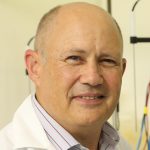
Technion researchers have developed the world’s first system using solar energy to split water into hydrogen and oxygen at two separate sites
Researchers at the Technion – Israel Institute of Technology have developed a prototype system for the efficient and safe production of hydrogen using only solar energy. Published in the journal Joule by the Cell group, the study was led by doctoral student Avigail Landman of the Grand Technion Energy Program, together with master’s student Rawan Halabi from the Faculty of Materials Science and Engineering. The study was conducted under the joint guidance of Professor Gideon Grader of the Faculty of Chemical Engineering and Professor Avner Rothschild of the Faculty of Materials Science and Engineering, in collaboration with Professor Adélio Mendes and Dr. Paula Dias of the University of Porto in Portugal.

The innovative system contains a tandem cell solar device, which enables more efficient utilization of the light spectrum. Some of the sun’s radiation is absorbed in the upper layer, which is made of semi-transparent iron oxide. The radiation that is not absorbed in this layer passes through it and is subsequently absorbed by a photovoltaic cell. Together, the two layers of the system provide the energy needed to decompose the water.
From Theory to Application
The innovative system is a continuation of the theoretical breakthrough by the Technion research team, presented in a March 2017 article in Nature Materials. In that article, the researchers introduced a paradigmatic shift in hydrogen production: Instead of one production cell where the water is broken down into hydrogen and oxygen, the researchers developed a system where hydrogen and oxygen are formed in two completely different cells. This development is important in part because mixing oxygen and hydrogen creates an explosive and dangerous interaction. The researchers presented the proof of feasibility in a laboratory system operated with a conventional power source.

Professor Gideon Grader
Now, in the current study in Joule, the researchers present the realization of the theory in applied development – a photoelectrochemical prototype system that produces hydrogen and oxygen in two separate cells using only sunlight. As part of the experiment, approximately 80 working hours (10 days of about 8 hours) were conducted, demonstrating the efficiency of the system in natural sunlight. The experiment was conducted in the Faculty of Chemical Engineering at the Technion.
Background
Hydrogen is a highly sought-after material in many areas of our lives. Most of the hydrogen generated today is used to make ammonia for the production of fertilizers that are essential for modern agriculture. Additionally, hydrogen is one of the leading alternative fuel sources, especially in the context of automotive propulsion. In the context of transportation, hydrogen has several advantages over mineral-based fuels:
- it can be generated from water using green energy such as solar energy, reducing dependence on mineral fuels and dependence on countries rich in oil reserves;
- hydrogen production from water allows the storage of renewable energy such as solar and wind, which are not available all hours of the day;
- unlike diesel and gasoline engines that emit large amounts of air pollution, the only byproduct of hydrogen engines is water.

Professor Adélio Mendes
Today, most of the world’s hydrogen is produced from natural gas. But with this process comes the emission of carbon dioxide (CO2), whose environmental damage is well known. An alternative production method is electrolysis – decomposition of water (H2O) for hydrogen (H2) and oxygen (O2). Although the electrolysis process was discovered more than two hundred years ago, not many electrolysis technologies have been developed. In recent years, with the vital transition to alternative energies, it has become clear that the electrolysis process needs to be refined to fit these energy sources.
Against this backdrop, the photoelectrochemical process developed, which breaks down the water directly using the Sunlight radiation. Although here too, there are various technological challenges. For example, the production of hydrogen using the conventional method of electrolysis – the decomposition of water into hydrogen and oxygen in the same production cell – involves risk because the encounter between hydrogen and oxygen leads to an explosion. Moreover, in large-scale solar fields, it is very difficult to produce hydrogen in this configuration. Hence the importance of the current breakthrough presented in Joule.

Dr. Paula Dias
The researchers hope that academics and industry will continue and advance the system into a commercial product.
The research was supported by the Nancy and Stephen Grand Technion Energy Program (GTEP), funding from U.S. donor Ed Satell, the Adelis Foundation, Ministry of Energy and the European Commission (two ERC grants), and the National Science Foundation PAT Excellence Center.
Read the most up to date Fuel Cell and Hydrogen Industry news at FuelCellsWorks




